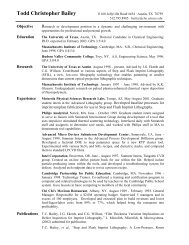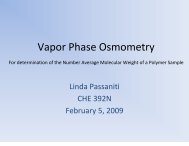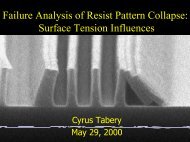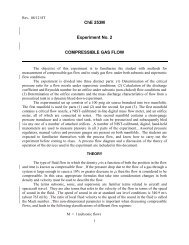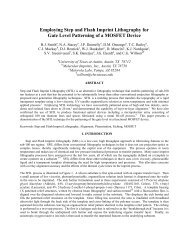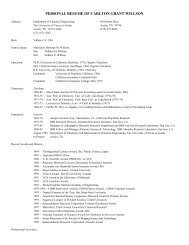Rayleigh Instability of an Annulus
Rayleigh Instability of an Annulus
Rayleigh Instability of an Annulus
Create successful ePaper yourself
Turn your PDF publications into a flip-book with our unique Google optimized e-Paper software.
Conservation <strong>of</strong> Momentum:<br />
ρ ∂ u'<br />
=−∇ p '<br />
(5)<br />
∂t<br />
Here ρ is the density <strong>of</strong> the fluid <strong>an</strong>d p' is the pressure in the fluid.<br />
Kinematic Expression:<br />
ur ' = ∂η<br />
∂t<br />
Here η is the length <strong>of</strong> the disturb<strong>an</strong>ce <strong>an</strong>d u' r is the radial velocity <strong>of</strong> the fluid.<br />
(6)<br />
For a sinusoidal disturb<strong>an</strong>ce p' , η, u' <strong>an</strong>d c<strong>an</strong> all be described by Β in the following<br />
expression:<br />
B= B ! exp ( st+ i( k z+<br />
n θ ))<br />
Here, s is the time factor, k is the wave number (k= 2π/λ where λ is the wavelength <strong>of</strong> the<br />
disturb<strong>an</strong>ce), <strong>an</strong>d n is the <strong>an</strong>gular number that determines the shape <strong>of</strong> the disturb<strong>an</strong>ce.<br />
The value <strong>of</strong> n is assumed to be zero (symmetrical disturb<strong>an</strong>ce) for this study to eliminate<br />
<strong>an</strong>y imaginary component <strong>of</strong> the solution. Combining equations 4 <strong>an</strong>d 5 yields the<br />
following differential equation whose solution is a zero order modified Bessel’s equation.<br />
The order <strong>of</strong> the Bessel equation is determined by the value <strong>of</strong> n.<br />
r dp 2<br />
!<br />
r dp !<br />
2<br />
2 2 2 2<br />
2 + − (r k + n ) p! = 0 = ∇ p'<br />
(6)<br />
dr dr<br />
Boundary Conditions<br />
!p (r) = AI ( kr) + BK ( kr)<br />
(7)<br />
n<br />
n<br />
The following boundary conditions were used to solve the differential equation.<br />
This first boundary condition requires that the normal stresses be bal<strong>an</strong>ced at the outer<br />
interface. This equation is also known as the Young-Laplace equation where n is the<br />
normal vector, γ is the surface tension <strong>of</strong> the fluid, <strong>an</strong>d a is the unperturbed outer radius<br />
<strong>of</strong> the <strong>an</strong>nulus (equivalent to a 0 in figure 1).<br />
2<br />
2<br />
p'| r= a+ =− ⎛ η<br />
⎜<br />
n<br />
⎝ a + ∂ η<br />
z + 1 ∂ η⎞<br />
η γ 2 2 2 2 ⎟ =∇•<br />
(8)<br />
∂ a ∂θ ⎠<br />
The second boundary condition comes from the fact that the radial velocity at the<br />
outer interface is equal to the time derivative <strong>of</strong> the length <strong>of</strong> the disturb<strong>an</strong>ce (equation 6).<br />
Ak<br />
u! '( ) '( )<br />
r a s I ka Bk<br />
s K ka ∂η<br />
r| = + =<br />
= +<br />
0 0<br />
(9)<br />
η ρ ρ<br />
∂t<br />
4



